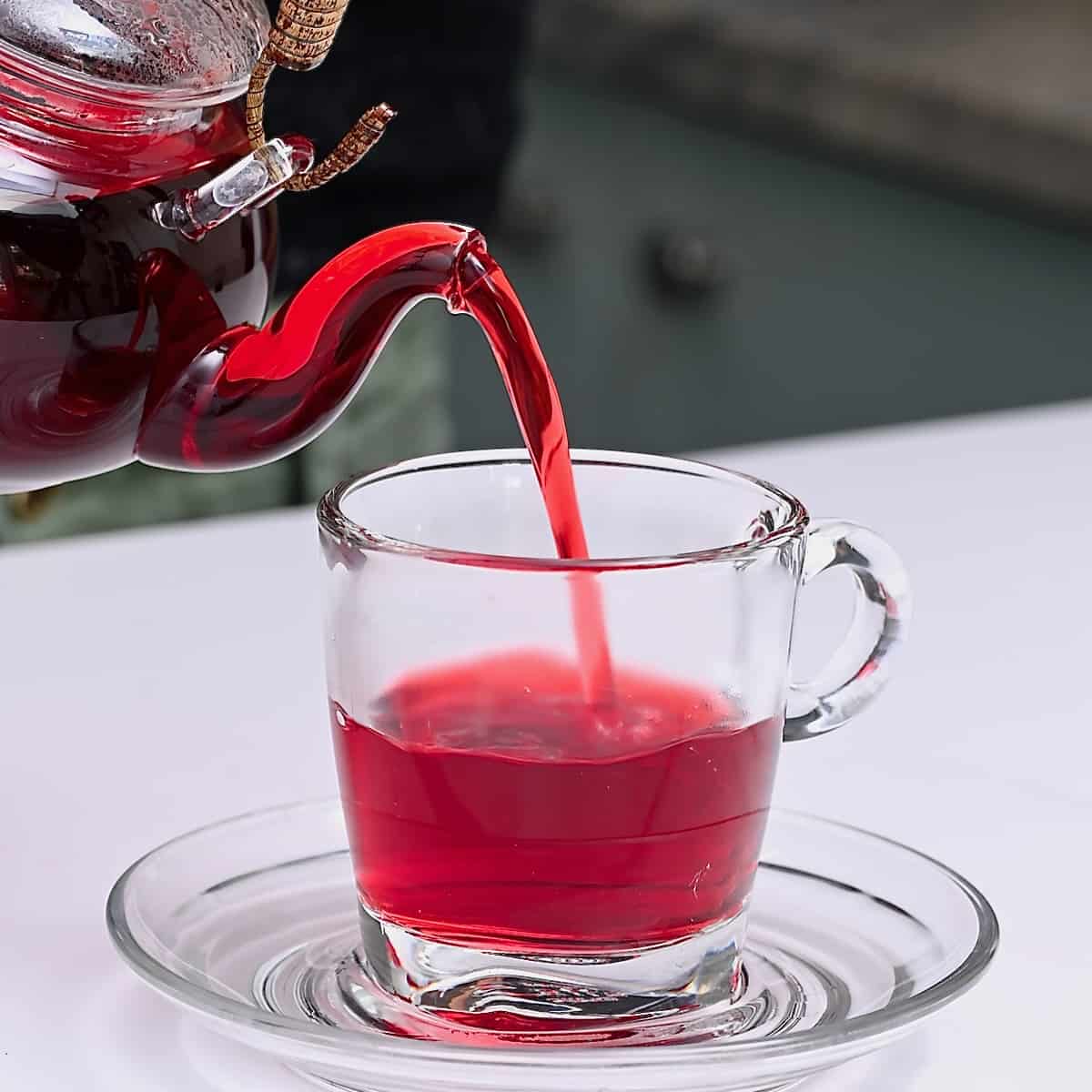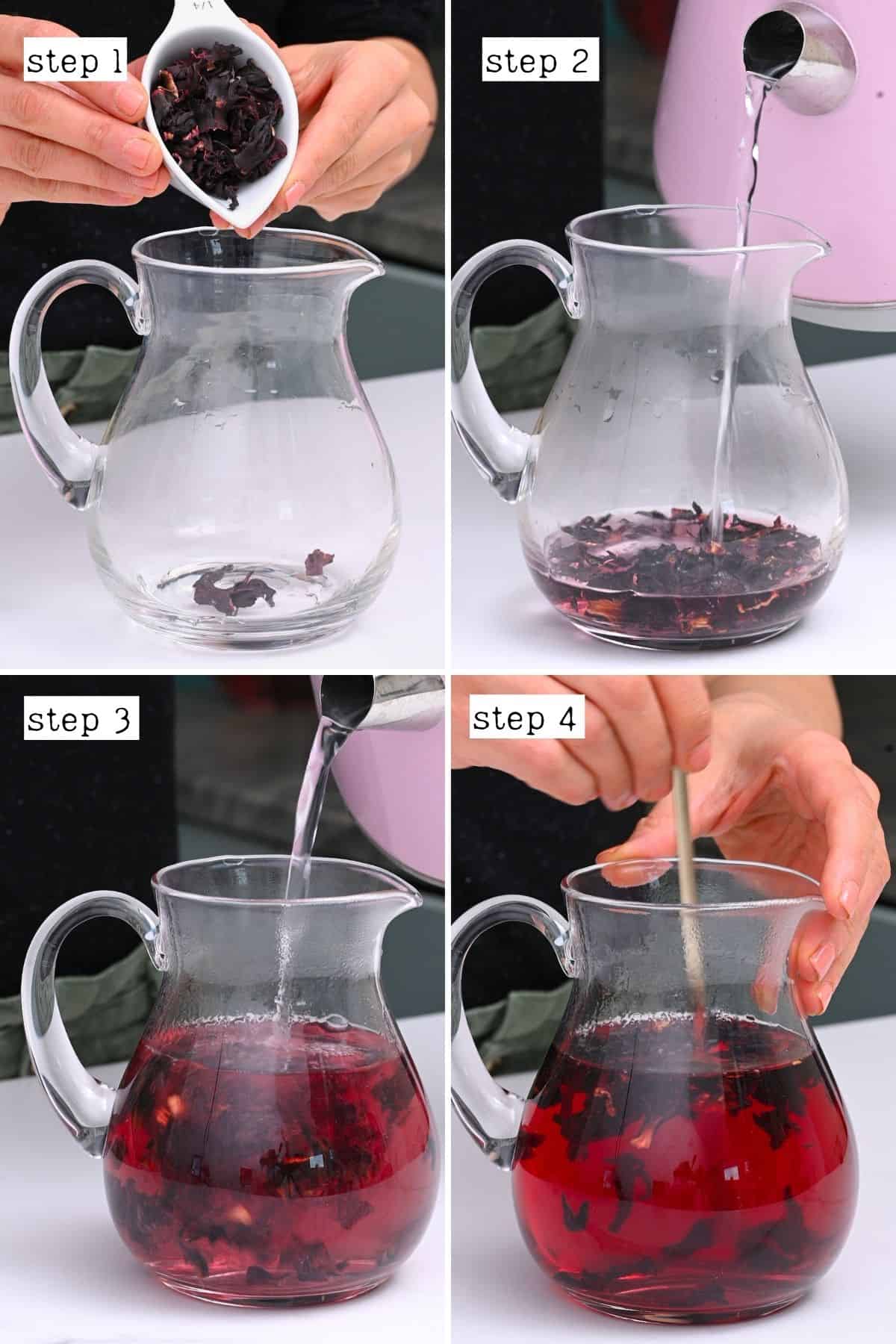To make hibiscus tea, steep dried hibiscus flowers in boiling water for five minutes, then strain. Serve the tea hot or chilled, sweetening to taste if desired.
Known for its deep red color and tangy flavor, hibiscus tea is a refreshing beverage enjoyed worldwide. This herbal tea, derived from the petals of the hibiscus flower, not only delivers a unique taste but also offers potential health benefits.
It’s naturally caffeine-free, making it a perfect drink for any time of the day. The preparation process is simple and requires just a few ingredients, ensuring that anyone can easily make it at home. Whether you seek a cozy warm drink or a cold refreshment, hibiscus tea is versatile, served either way. It has gained popularity as a delightful option for those who are health-conscious or looking to explore herbal teas beyond the traditional camellia sinensis varieties.
Origins Of Hibiscus Tea
The delightful journey of hibiscus tea begins deep within ancient cultures. Known for its vibrant color and tart flavor, this crimson drink whispers tales of the past. Let’s dip into history and discover the rich tapestry that makes hibiscus tea a time-honored beverage.
Cultural Roots And Historical Use
Hibiscus tea originates from North Africa and Southeast Asia. It now spreads joy worldwide. Known as ‘Karkade’ in Egypt, it graced pharaohs’ tables. In West Africa, hibiscus symbolizes tradition and festivity. Parts of Europe saw it as a gift when tea leaves were rare.
- In Egypt and Sudan, wedding celebrations feature hibiscus tea.
- Caribbean folks savor it as ‘sorrel’ during end-of-year festivities.
- It’s called ‘Agua de Jamaica’ in Mexico, enjoyed both hot and cold.
Celebrations across the globe shine brighter with hibiscus tea in hand.
Health Benefits Through The Ages
Not only a joy to sip, but hibiscus tea is also a historic remedy. Its journey through time showcases its power to heal and refresh. From pharaohs to healers, all recognized its value.
- High in vitamin C, it boosts immunity.
- Rich in antioxidants, it combats aging.
- Works to lower blood pressure, promoting heart health.
Ages have passed, and yet the health benefits of hibiscus tea remain timeless.

Credit: www.loveandlemons.com
Choosing The Right Hibiscus
Making the perfect cup of hibiscus tea starts with the right flower. The choice of hibiscus is crucial, as it determines the flavor, color, and overall quality of your tea. Let’s explore how to pick the best hibiscus for a refreshing and delicious brew that’s full of natural goodness.
Dried Vs. Fresh Hibiscus Flowers
Dried hibiscus flowers are commonly used for tea. They offer a more intense flavor and are available year-round. Fresh hibiscus flowers can also be used but are less concentrated and have a milder taste.
- Dried Hibiscus
- More intense flavor
- Longer shelf life
- Convenient for storage
- Fresh Hibiscus
- Gentler taste
- Natural and fresh
- Seasonal availability
Sourcing Quality Hibiscus
Quality is key in the vibrant taste and color of your tea. Look for organic, non-GMO hibiscus. This ensures the flowers are grown without harmful chemicals. Find them at health food stores, online retailers, or local markets.
| Source | Quality | Availability |
|---|---|---|
| Health Food Stores | Usually organic | Depends on location |
| Online Retailers | Wide selection | All year |
| Local Markets | Freshness | Seasonal |
Preparation Essentials
Before diving into the aromatic world of hibiscus tea, let’s gather the tools and learn the petal prep. Careful attention here means a better brew. Gentle handling retains the flower’s delicate essence. Ready to make your tastebuds dance? Let’s start.
Required Utensils And Containers
Creating the perfect cup of hibiscus tea starts with the right gear. Here’s what you need:
- Teapot or Saucepan: For brewing the petals.
- Strainer: To catch petals after steeping.
- Measuring Spoon: For petal precision.
- Heatproof Cup: Ready for hot liquid.
- Spoon: To stir sweetness into the mix.
Cleansing And Handling Of Hibiscus Petals
Treat hibiscus petals with care for tea that tastes divine:
- Source Quality Petals: Fresh or dried matter.
- Rinse Gently: Cool water does the trick.
- Pat Dry: Softly with a clean cloth.
Brewing follows these steps.Each cup brings a refreshingly tart flavor, bursting with benefits.

Credit: www.alphafoodie.com
Brewing Techniques
Discovering the perfect way to brew hibiscus tea is an art as much as it is a science. Hibiscus tea, celebrated for its deep red color and tart flavor, can be brewed to suit any palate. The process is simple and allows for customization in strength and taste. Follow these techniques to craft the ideal cup.
Step-by-step Infusion Process
Begin with these easy steps to infuse the bold essence of hibiscus into your next cup:
- Select high-quality dried hibiscus flowers for the best results.
- Measure 1-2 teaspoons of dried hibiscus per cup of water, depending on your preference.
- Boil the water and pour it over the hibiscus in a teapot or heat-proof container.
- Cover and steep for 5 minutes. Longer steeping intensifies the flavor and color.
- Strain the tea into cups, catching any loose petals.
- Optionally, sweeten with honey or sugar to balance the tartness.
Adjusting Strength And Flavor
To find your ideal hibiscus tea’s concentration and taste, consider these tips:
- Add more flowers for a more robust tea.
- Steep for fewer minutes for a lighter brew.
- Experiment with add-ins like cinnamon, lemon, or mint for unique twists.
- Mix hibiscus with other teas, such as green or black, for a flavorful blend.
Remember, the longer you steep, the more intense the flavor gets. Start with a shorter steeping time and adjust according to your taste.
Serving Suggestions
Once you’ve made a vibrant batch of hibiscus tea, the fun truly begins. It’s time to serve it up in style. Whether you prefer a hot comforting mug or a chilled, refreshing glass, there are countless ways to enjoy this tart beverage. Let’s explore how to relish your homemade hibiscus tea to the fullest with some serving tips.
Hot Vs. Cold Hibiscus Tea
Hot Hibiscus Tea warms you up on a cold day. Serve in a mug with a slice of lemon. For Cold Hibiscus Tea, pour over ice. It will cool you down when the sun is high. Here’s how to make each one special:
- Hot Tea: Use a ceramic mug to retain heat.
- Cold Tea: A tall glass brings out its crimson hue.
Sweeteners And Additional Flavorings
Sweeten your hibiscus tea to taste. Natural sweeteners like honey or agave blend beautifully. Infuse extra flavors using spices or fruits. Here are options to start your flavor adventure:
| Sweetener | Flavor Add-ins |
|---|---|
| Honey | Cinnamon sticks |
| Agave syrup | Fresh ginger slices |
| Stevia | Mint leaves |
Experiment with quantities until you find your perfect blend. Enjoyment awaits in every sip!

Credit: www.alphafoodie.com
Creative Twists On Traditional Hibiscus Tea
Kick your tea game up a notch by exploring creative twists on traditional hibiscus tea. Perfect for a refreshingly tart taste and a deep crimson color, hibiscus tea is versatile. Get inspired to mix it up with other herbal infusions or create an original mocktail. Your tea experience is about to get exciting.
Incorporating Other Herbal Blends
Enhance the flavor profile of hibiscus tea. Combine it with other herbs for a new twist. A popular choice is chamomile for a soothing nighttime blend. Consider these blends:
- Mint: Adds a refreshing zing, perfect for summer.
- Ginger: Provides a spicy kick and digestive benefits.
- Lemongrass: Introduces a citrusy note, complementing the tartness.
Simply mix dried herbs with hibiscus flowers in equal parts. Brew as usual and enjoy a flavorful cup of herbal delight.
Cocktails And Mocktails Recipes
Turn your hibiscus tea into a party favorite. Create colorful cocktails or mocktails. Start with a hibiscus tea concentrate:
- Brew a strong batch of hibiscus tea.
- Sweeten to taste with honey or sugar.
- Chill in the refrigerator.
Now, let’s make some drinks:
| Drink | Ingredients | Instructions |
|---|---|---|
| Hibiscus Highball | Rum, lime juice, hibiscus concentrate | Combine ingredients with ice in a highball glass. |
| Sparkling Roselle | Sparkling water, hibiscus concentrate, lime wheel | Top hibiscus concentrate with sparkling water. Garnish with lime. |
| Hibiscus Sunrise | Orange juice, hibiscus concentrate, grenadine | Layer in a glass for a sunrise effect. |
For a non-alcoholic treat, replace spirits with tonic water or soda. Add fruit garnishes for an extra touch. You now have the recipes for refreshing drinks that are sure to impress.
Frequently Asked Questions For How To Make Hibiscus Tea
Can You Make Hibiscus Tea From All Hibiscus Flowers?
Not all hibiscus flowers are suitable for making hibiscus tea. Only the Hibiscus sabdariffa variety is commonly used for its edible petals and tangy flavor. Always verify the hibiscus variety before consumption.
How Much Hibiscus Do I Need For A Cup Of Tea?
For a cup of hibiscus tea, use 1. 5 to 2 teaspoons of dried hibiscus flowers. Steep them in boiling water for 5 minutes.
Do You Have To Dry Hibiscus Flowers For Tea?
Yes, drying hibiscus flowers is necessary for making tea, as it concentrates the flavors and preserves the petals.
What To Avoid When Drinking Hibiscus Tea?
Avoid drinking hibiscus tea with meals as it may hinder nutrient absorption. Pregnant women should steer clear of it due to possible hormonal effects. Limit consumption if taking prescribed medication, to prevent potential interactions. Drink moderately to avoid possible blood pressure drops or hallucinogenic effects.
Conclusion
Crafting hibiscus tea is both an art and a wellness practice. Embrace the simplicity of this refreshing beverage and benefit from its health properties. Let the rich, crimson hue and tart flavor brighten your day. Share the experience with friends or savor a quiet moment alone, tea in hand.
Cheers to your healthful journey with hibiscus tea!








